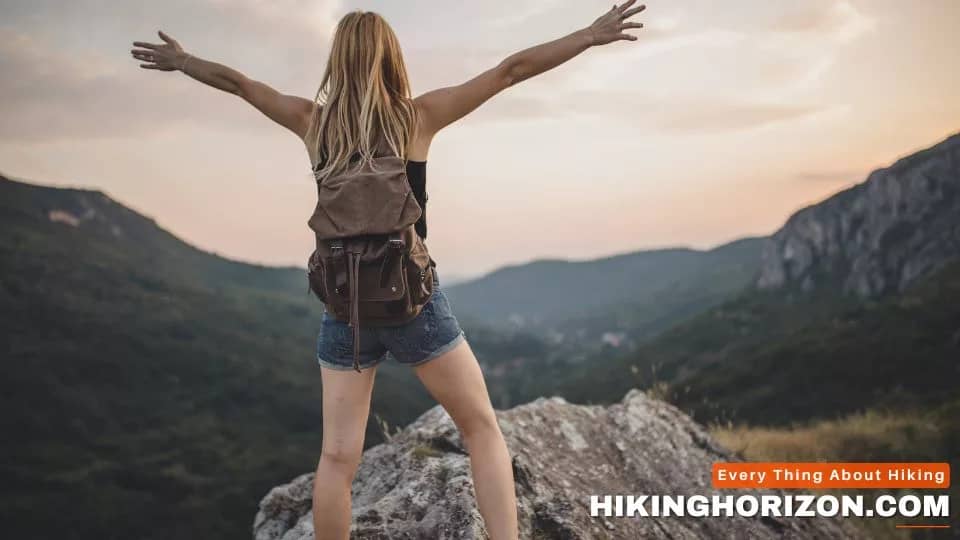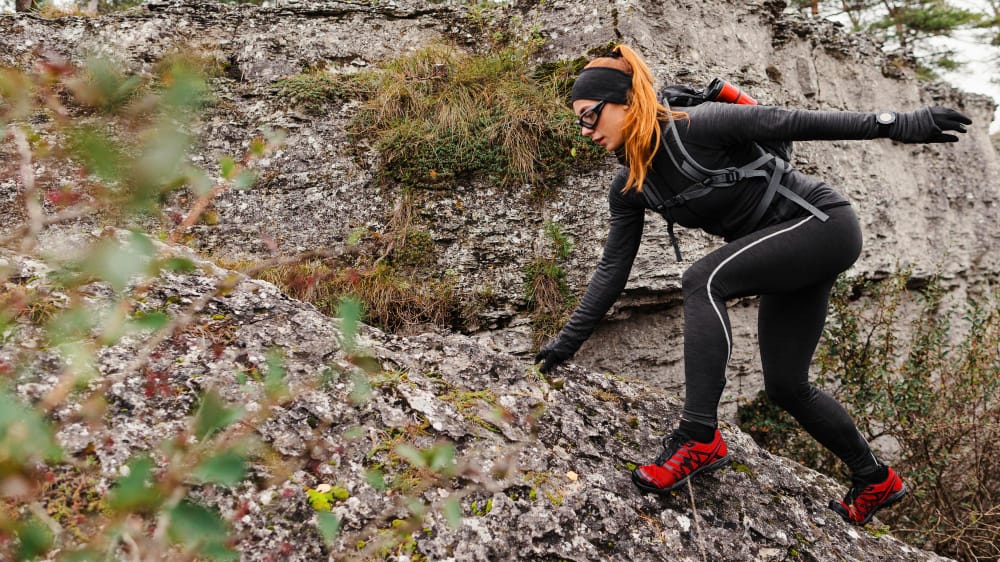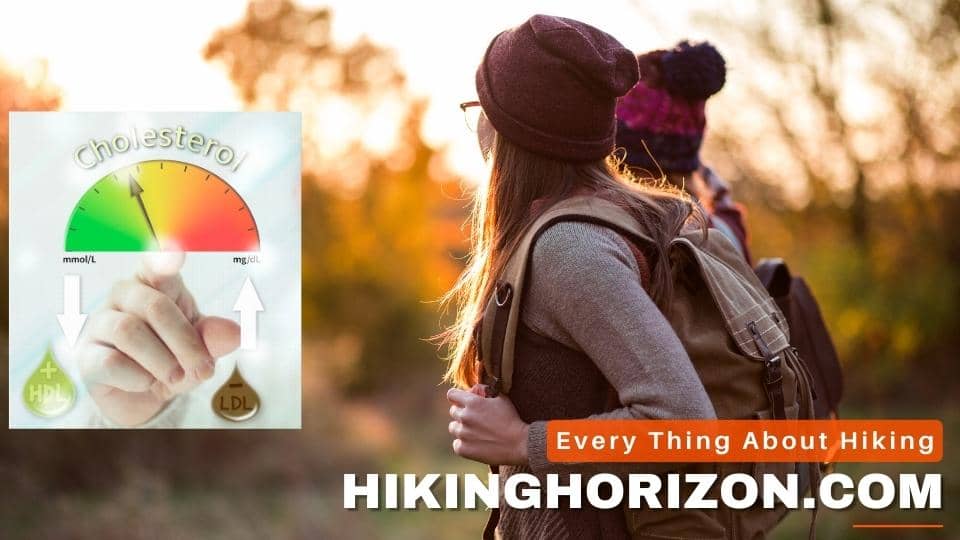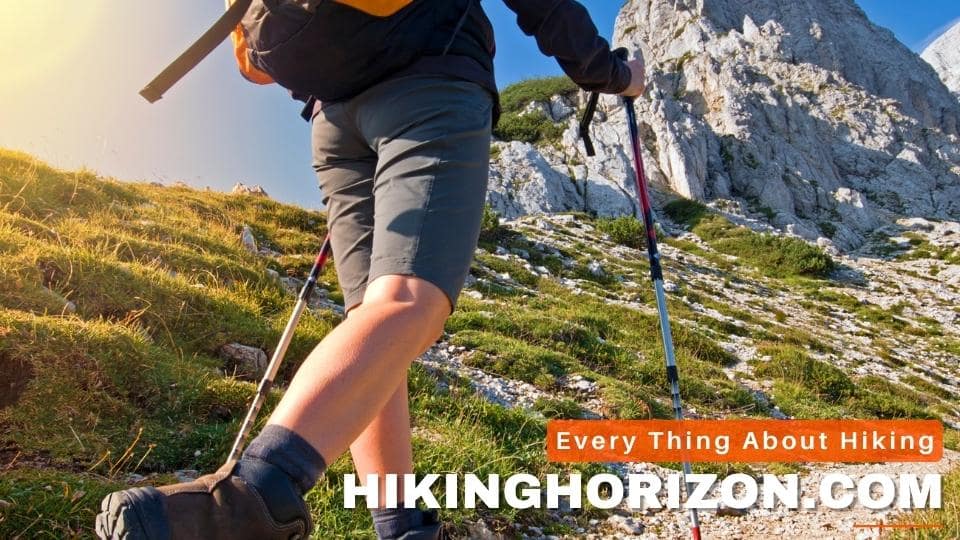
Hiking through nature is a favorite pastime for many outdoor enthusiasts. The fresh air, beautiful scenery, and sense of adventure make hiking an appealing activity. But like other hikers, you may wonder, does hiking tone your body? Yes, It can help tone and shape your body when done regularly.
In this guide, we’ll explore how hiking can transform your physique. We’ll discuss:
- The muscle groups worked by hiking
- Weight loss and calorie burn from hiking
- How to maximize fitness gains on the trail
- Ideal hiking workout plans
- Additional exercises to build hiking-specific strength
- Proper nutrition to fuel hikes
- Recovery tips for active rest
So lace up your boots, and let’s hit the trails to uncover how hiking can tone your whole body!
Table of Contents
Hiking Builds Functional Fitness ─ health benefits of hiking
Slogging up steep inclines with a loaded pack builds tremendous full-body endurance. According to a 2021 study in the Journal of Strength and Conditioning Research, hikers can burn over 500 calories per hour when trekking uphill with weight. This exceeds the calories burned during casual walking or even jogging on level ground.
Unlike gym machines that isolate muscle groups, hiking provides functional fitness—training multiple muscles simultaneously as you would use them in real life. The constant core engagement, balance shifts, and muscle coordination required to build athleticism are directly transferable to daily activity. No workout better prepares the body for everything from yard work to racing after kids.
We’ll highlight exactly which muscle groups contribute to making hiking such a worthwhile endeavor for sculpting total body strength, endurance, balance, and coordination. Let’s discover how moving through nature rather than just static weights or cardio machines can transform your physique.
Does hiking tone your body? Which Muscles Does Hiking Work & Tone

Hiking works the body from head to toe. It targets often-neglected stabilizer muscles along with the major muscle groups. Here are the prime areas toned by time on the trails.
Core Muscles
The core includes the abdominal and lower back muscles. Hiking engages your core constantly to maintain balance while carrying weight and navigating uneven terrain. The core stabilizes your torso with every step.
Studies show core muscle activation during loaded hiking exceeds that of conventional crunches and planks. The Journal of Sport Rehabilitation found hikers’ rectus abdominis, obliques, and erector spinae muscles showed greater electromyography (EMG) activity compared to standard core exercises.
Bringing your core to mountain trails builds tremendous functional strength directly transferable to everyday movement. Don’t underestimate hiking’s core benefits.
Related Articles:
- Can Hiking Keep You In Shape? 10 Reasons Why Hiking Is A Sculpting Exercise
- Can Hiking Build Muscle? The Ultimate Guide to Hiking and Muscle Development
- Does Hiking Work Your Core? Yes! Hiking Build Muscle And Strengthen Your Core
Leg Muscles
The glutes, quads, hamstrings, and calves power each step during hiking. Walking uphill requires continuous leg drive against gravity, developing incredible lower body endurance.
A 2020 study in the International Journal of Environmental Research and Public Health confirmed hikers experience substantial muscle force generation in quads, hamstrings, and calf muscles when ascending slopes, especially while carrying weight. Downhill grades also eccentrically load leg muscles to build strength.
Targeted step-ups, lunges, and plow stops along the trail further work the legs through a large range of motion. Hiking’s varied terrain recruits more muscle fibers as you react and respond to the changing landscape.
Related Articles:
- What Are Hiking Benefits For Legs? Discover How Hiking Builds Muscle!
- Does Hiking Make Your Legs Slimmer? Yes! Incline Hiking Tone Legs And Slim Your Thigh
- Does Hiking Tone Legs? Yes! Discover How Hiking Tone Your Legs
Shoulders and Back
Carrying weight in a backpack tones the shoulders, upper back, lats, and rhomboids. The deltoid muscles bear and stabilize shoulder straps, while the traps and lats are called upon to retract the shoulder blades for postural endurance under a pack.
Studies confirm substantial upper back and shoulder activity is required to stabilize loads during hiking. A 2018 study in the Journal of Physical Therapy Science found subjects carrying 20-30% bodyweight packs experienced significant upper trapezius and erector spinae muscle activation.
As hiking distance and pack weight increase, the muscular demands grow exponentially. Miles trekked under a loaded pack, building tremendous upper body fatigued resistance critical for real-world strength.
Related Articles:
- Can Hiking Hurt Your Back? 6 Tips for Hikers To Prevent Lower Back Pain While Hiking
- Does Hiking Build Glutes? The Secrets to Building Muscle While Hiking
Arms and Grip
Biceps and triceps engage to provide arm drive during trekking pole use. Wielding poles gets the arms into the action, building pushing and pulling strength to take pressure off the legs.
Expert hiker Jennifer Hill comments: “I was amazed how sore my arms got after using trekking poles on a long hike! It really works those biceps and triceps to stabilize and drive each stride.”
Hikers also develop incredible grip strength, maintaining hold of poles and stabilizing loads. Traction of shoes on loose surfaces further engages the hands and forearms.
Ankles and Feet
Varied trail terrain strengthens muscles throughout the feet and ankles. Hiking’s constant balancing over rocks and roots builds tremendous intrinsic foot muscle endurance. Lateral slopes and cambered trails strengthen ankle stabilizers.
According to podiatrist Dr. Mark Blake, “Hikers develop remarkable proprioception and foot stability from adapting to uneven, unsteady ground with every step.”
This ankle and foot coordination carries over into athletic activities, preventing injury. Hiking is unparalleled functional training.
| Muscle Group | How Hiking Works/Tones This Muscle |
|---|---|
| Core (abdominals, lower back) | Engages core muscles to maintain balance and stabilize body while carrying pack and hiking on uneven terrain |
| Legs (glutes, quads, hamstrings, calves) | Walking uphill requires continuous leg drive against gravity to propel body upwards |
| Shoulders and Upper Back | Carrying weight in backpack tones shoulders, upper back, lats and rhomboids as they stabilize and support pack |
| Arms and Grip | Using trekking poles engages biceps, triceps and grip strength to stabilize body and drive poles with each step |
| Ankles and Feet | Varied trail terrain strengthens ankle and foot muscles as they react to uneven ground and shifting weight with each step |
Hiking a good workout for Weight Loss and Calorie Burn
Along with strengthening muscles, hiking can also torch calories for weight loss and fitness. Calorie expenditure varies based on the difficulty of the terrain. Let’s examine how your choice of trail factors into calories burned.
Calorie Burn Hiking Uphill
Hiking uphill requires tremendous energy expenditure to lift your body against gravity. A 170lb person will burn around 532 calories hiking uphill for one hour at a pace of 4mph on a 10% incline.
Steeper grades burn more calories as leg muscles must work harder with each step. Calorie burn exceeds running at higher inclines.
Hiking Downhill Calorie Expenditure
Descending slopes still requires moderate calorie burn, around 344 calories for a 170lb hiker over one hour at 4mph, per Harvard Medical School estimates. Leg muscles stabilize and control strides eccentrically.
Total calories for a hike equal uphill and downhill portions combined. Varying terrain maximizes total workout benefits.
Burning Calories Hiking on Flat Ground
Expect to burn around 298 calories per hour hiking on flat, level trails at a moderate pace. Flatter ground still engages your muscles throughout, especially while carrying weight.
Adding pole use, heavier packs, or increased speed can further elevate flat ground calorie expenditure for a greater burn.
Tips for Maximizing Fitness Gains on the Trail

Optimizing your hiking workout takes more than just hitting the trails. These key tips will help you sculpt your body more effectively:
Choose Steep, Challenging Trails
Prioritize steeper routes several times per week to maximize lower body strength gains. Varying inclines engage all muscle fibers. Seek ascents over 10% grade for the greatest burn.
Increase Your Pack Weight
Start with 20% body weight loads, increasing 5lbs at a time as you build strength. Heavier packs tone your upper body and raise calorie burn. But ensure excellent hiking boots and conditioning to avoid injury.
Incorporate Trekking Poles
Actively drive poles to engage arm, grip, and shoulder muscles more. Don’t just use poles for balance. Lean into them to propel strides. Vary hand positions for muscle recruitment.
Add Weightlifting To Complement Hikes
Squats, lunges, deadlifts, and upper body pressing strength train muscles in ways hiking can’t. Lift twice a week to maximize tone. Yoga builds stability.
Slow Down On Downhills
Walking deliberately downhill in a controlled, engaged form works eccentric leg strength. But avoid overstriding with poor form, which can lead to pain.
Know Your Stats
Wear a GPS watch or fitness tracker to monitor mileage, elevation gain, pace, heart rate intensity, and total calories burned during each hike. Reviewing stats helps optimize workouts.
Bring Proper Nutrition
Pack protein bars and snacks to fuel muscles and replenish calories burned. Time nutrients 30-60 minutes pre-hike for energy. Proper fueling and hydration enhance performance.
| Tip | How It Maximizes Fitness Gains |
|---|---|
| Choose steep, challenging trails | Inclines and varied terrain engage more muscles and burn more calories |
| Increase pack weight | Heavier packs progressively overload shoulders, back, and legs to build strength |
| Incorporate trekking poles | Actively driving poles engages arm, grip, and shoulder muscles more |
| Add weightlifting | Squats, lunges, presses strengthen muscles in ways hiking can’t |
| Slow down on downhills | Controlled downhill form works muscles eccentrically |
| Monitor stats | Tracking mileage, pace, elevation helps optimize workouts |
| Proper nutrition | Protein, carbs, hydration before/during/after hiking fuels muscles |
| Periodized training | Varying workouts, recovery allows progressive overload |
Ideal Hiking Workout Plans

To maximize hiking fitness results, employ purposeful training principles. Follow a periodized workout schedule that combines hiking with strength training. Here are sample weekly plans:
For Strength Building
- Monday: Lower body and core weights workout
- Squats, lunges, deadlifts 3×5
- Plank variations crunches 3×10
- Tuesday: Heavy pack uphill hike
- 5 miles
- 20%+ incline
- 30lb pack
- Wednesday: Upper body weights
- Shoulder press, rows 3×5
- Biceps curls, tricep extensions 3×10
- Thursday: Low to moderate pack hike
- 8 miles
- 10% grade hills
- 20lb pack
- Friday: Active recovery
- Yoga, stretch
- Weekend: Long hike
- 10+ miles
- Mixed terrain
For Fat Loss
- Monday: Hill intervals
- Hike uphill sprints x10
- Jog down recovery
- Tuesday: Lower body weights
- Squats, lunges, calf raises 3×15
- Wednesday: Steady state hike
- 5-6 miles
- Moderate pace
- Thursday: High-intensity hike
- Time-based fartleks
- Variable speed
- Friday: Active recovery
- Light hiking, mobility work
- Weekend: Distance hike
- 8-10 miles
- Moderate pack optional
For Endurance
- Monday: Hill repeats
- Short, steep climbs x5
- Tuesday: Medium hike
- 6-8 miles mixed terrain
- Wednesday: Lower body weights
- Squats, lunges 2×15
- Thursday: Progression hike
- 8-10 miles
- Increase pack weight
- Friday: Upper body weights
- Push-ups, rows 2×15
- Saturday: Distance hike
- 10-12 miles
- Sunday: Recovery
- Yoga, foam roll
Adjust for your unique goals, but follow the methodology of progression. Vary workouts while allowing rest to maximize fitness.
Added Exercises For Hiking-Specific Strength

Complement trail miles with targeted exercises that build hiking-applicable strength. Focus on joint integrity and muscular endurance. Useful options include:
Ankle Strengthening
- Calf raises, banded ankle walks, single-leg hops – build ankle joint stability to prevent rolls on uneven terrain.
Balance Work
- Standing storks, single-leg RDLs, and BOSU squats – improve proprioception and balance over varied trail surfaces.
Stair Climbing
- Simulates uphill hiking – drive knees and glutes up real-world inclines without the pounding of running.
Core and Postural Exercises
- Planks, side planks, bird dogs – replicate core demands of hiking with pack to prevent back pain.
- Band pull aparts, face pulls – strengthen upper back to withstand miles under pack weight.
Hip and Glute Strengthening
- Bridges, clamshells, and lateral walks – target weak glutes and outer hip muscles. Prevent IT Band issues.
Quad, Hamstring and Calf Exercises
- Step ups, lunges, Nordic curls – build leg stamina for mile after mile of hill climbs.
Grip Strengthening
- Holds, pinches, springs – improve hand and forearm endurance for using trekking poles over distance.
Add these 1-2 times per week to create the ultimate hiking-toned physique.
| Focus | Sample Exercises | How They Enhance Hiking |
|---|---|---|
| Ankle Strength | Calf raises, banded ankle walks, single-leg hops | Build ankle stability for uneven terrain |
| Balance | Standing storks, single-leg RDLs, BOSU squats | Improve proprioception over varied surfaces |
| Stair Climbing | Simulating uphill climbing | Prep legs for real-world inclines without impact |
| Core and Posture | Planks, bird dogs, band pull aparts | Replicate demands of hiking with pack |
| Hips and Glutes | Bridges, clamshells, lateral walks | Target weak areas to prevent injuries |
| Legs | Step ups, lunges, Nordic curls | Build leg endurance for miles of climbing |
| Grip | Holds, pinches, grippers | Improve pole and traction strength |
Diet and Nutrition For Hiking Performance
Fueling properly before, during, and after hikes maximizes energy levels while aiding muscle recovery. Follow these nutrition tips:
Pre-Hike Meals
- Eat 1-2 hours pre-hike for digestion
- Focus on carbs – oats, sweet potatoes, quinoa
- Moderate protein – eggs, turkey, nut butter
- Healthy fat – avocado, olive oil, nuts
- Hydrate well in the days prior
High-Energy Hiking Snacks
- Trail mix – nuts, seeds, dried fruit
- Nut butter packets with pretzels or apple slices
- Protein bars – look for 20g protein, under 30g carbs
- Jerky or smoked salmon packs
- Fresh fruit – bananas, oranges, berries
Post-Hike Recovery Foods
- Chocolate milk – carbohydrates and protein
- Yogurt and berries – probiotics, antioxidants
- Rice bowls with chicken or fish
- Veggie omelet with avocado
- Protein smoothie with leafy greens, nut butter
Proper on-trail hydration is also crucial – drink frequently from bladders or bottles to avoid dehydration cramps. Time nutrients and fluids strategically to power miles and muscle repair.
Related Article: What To Eat Before Hiking? The Best Breakfast To Eat Before A Day Hike
Recovery Tips For Active Rest

Vigorous activity like hiking demands periods of lower intensity for tissue healing and adaptation. Balance workouts with active rest using these techniques:
- Easy hikes – low-intensity trail walks increase blood flow without further fatiguing muscles
- Yoga – improves flexibility and reduces muscle tissue adhesions/scar tissue
- Foam rolling – releases muscle knot tension accumulated from repetitive strides
- Contrast baths – alternating hot and cold water exposure improves circulation
- Massage – aids fascia health and recovery, reduces muscle lesion buildup
- Sleep – ensures sufficient rest for tissue rebuilding and CNS recovery
- Nutrition – quality calories and ample protein enhance repair
Schedule dedicated recovery sessions for optimal gains from your hiking workouts. Don’t let overtraining diminish your progress.
FAQs about hiking as a good exercise for core muscles and endurance
Q: What does hiking do to your body shape?
A: Hiking can help transform your body shape over time. The walking and climbing involved in hiking work many different muscle groups in your upper body muscles and lower body muscles, including your abdominal muscles, quadriceps muscles, and muscles in your legs. The varied terrain stabilizes your body as you walk on uneven hiking trails, engaging more muscles than walking on flat surfaces. Think of hiking as an excellent form of exercise to tone your muscles and help you build strength and endurance.
Q: Does hiking tone your stomach?
A: Yes, hiking can be a great way to tone your abdominal muscles. The activity of hiking works the abdominal muscles as they stabilize your body with each step, especially as you walk uphill or climb over rocks and logs. Hiking may help tone and strengthen your stomach muscles over time.
Q: Will hiking reduce cellulite?
A: Hiking may help reduce the appearance of cellulite to some degree over time. Walking and climbing hills on uneven terrain engages the muscles in your lower body, including your quadriceps muscles and the back of your lower leg. Building muscle mass and tone in these large muscles through hiking can help smooth the appearance of cellulite. However, results will vary based on the frequency, duration, and intensity of your hikes.
Q: Is hiking a fat burner?
A: Yes, hiking can be a great fat-burning exercise. Hiking on uneven terrain requires more energy expenditure than walking on flat ground. The varied movement pattern works for large muscle groups in your legs, glutes, and core, helping to burn calories and body fat. Hiking is a great way to get your heart rate up and give your body an excellent cardio and strength workout.
Q: How long does it take to get in shape from hiking?
A: How quickly hiking gets you in shape depends on several factors like your starting fitness level, the difficulty of the trails, and how often you hike. For many people, hiking 2-3 times per week for 30-60 minutes could lead to increased muscle tone, endurance, and cardiovascular fitness within a few weeks or months. Consistency is key. Combining hiking with strength training and a healthy diet may help you get fit even faster. Be patient as you gradually increase the duration and intensity of your hikes.
Q: Will hiking tone my thighs?
A: Yes, hiking is an excellent way to tone your thigh muscles. Walking uphill and on uneven terrain specifically targets your quadriceps muscles on the front of your thighs. Using hiking poles can further engage the muscles on the back of your lower leg and thighs. Start slowly and increase the duration and difficulty of your hikes to continually challenge your leg muscles. You should notice more defined, toned thighs after hiking regularly for several weeks.
Q: Does hiking tone your glutes?
A: Hiking is a great exercise to help tone your gluteal muscles or “glutes.” Walking uphill recruits your glute muscles to power each step. Hiking’s varied terrain also requires your glutes to activate frequently to stabilize your body on uneven ground. Try taking bigger steps or using hiking poles to further engage your glutes. Over time, regular hiking should help lift and tone the muscles in your backside.
Q: How long does it take to tone legs hiking?
A: Most hikers notice increased muscle tone in their legs within 2-4 weeks of hiking regularly, but results depend on several factors. Hiking at least 2-3 times per week for 30+ minutes over hilly terrain will best work the muscles in your legs. Using poles engages additional leg muscles. Combine hiking with lower-body strength training for faster toning. Be patient, hike often on routes with varied terrain, and give your leg muscles time to adapt and become more defined.
Conclusion: Hiking Builds Muscle & Transform Your Fitness
As this guide has shown, hiking provides an incredibly comprehensive exercise stimulus unmatched by gym machines. The functional fitness developed through varied trail terrain builds athleticism directly applicable to daily life.
Hiking tones the legs, core, back, shoulders and arm muscles when progressively overloaded with duration, incline, and pack weight. It also burns substantial calories for weight loss. Following a purposeful workout schedule, along with targeted strength training and proper recovery, will sculpt your ideal hiking-toned physique.
So escape gym monotony and experience the motivation of moving through nature. Let the trails strengthen your body from head to toe as you breathe fresh air and soak up the views. Hiking offers a journey for the body, mind and soul when pursued with fitness in mind.

John Smith
John has been an avid hiker for over ten years and has explored some of the most challenging trails across the USA. He has completed multiple long-distance hikes, including the Appalachian and Pacific Crest Trails. John is also a certified hiking guide, leading several hiking trips for groups of all ages and skill levels.

John Smith
John has been an avid hiker for over ten years and has explored some of the most challenging trails across the USA. He has completed multiple long-distance hikes, including the Appalachian and Pacific Crest Trails. John is also a certified hiking guide, leading several hiking trips for groups of all ages and skill levels.




I just like the helpful information you provide in your articles
I do not even understand how I ended up here, but I assumed this publish used to be great
I appreciate the effort that goes into creating high-quality content, and this post was no exception. The insights and information were top-notch and made for a really engaging read. Keep up the great work!
Thank you for the amazing blog post!
I just like the helpful information you provide in your articles
I very delighted to find this internet site on bing, just what I was searching for as well saved to fav